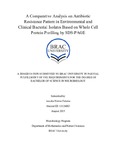| dc.description.abstract | This comparative study was carried out to investigate the presence of antibiotic sensitive and resistant bacteria in different environmental samples of Bangladesh with specific clinical strain obtained from ICDDR, B. The environmental samples were isolated from different locations of Dhaka city to perceive the propensity of the environmental isolates to develop antibiotic resistance. The bacterial isolates were identified on the basis of standard cultural, morphological and biochemical characteristics. Antibiogram was done to identify the antibiotic susceptibility of the isolates according to Clinical and Laboratory Standards Institute (CLSI) guideline. The result of this study indicated all the environmental isolates have become resistant to the tested antibiotics, and some of them have become multi-resistant to these therapeutic agents whereas all the clinical isolates showed the opposite result. The study helps to predict the future emergence and guide the development of strategies to counteract this resistance. Therefore comprehensive survey of antibiotic resistance in the environmental bacteria is required.
This comparative study was carried out to investigate the difference in protein band of resistant strain of E.coli and Staphylococcus aureus isolated from different environmental samples of Bangladesh along with specific clinical strain obtained from ICDDR, B of E.coli and Staphylococcus aureus. The antibiotic resistance of the identified organisms was carried out by disc diffusion method with commercially available disc of Sulfamethoxazole / Trimethoprim (SXT 25), Cefoxitin (FOX 30), Pefloxacin (PEF 5), Ciprofloxacin (CIP 5), Erythromycin (E 15), Gentamicin (CN 10), Kanamycin (K 30), Streptomycin (S 10), Cefuroxime Sodium (CXM 30), Nalidixic Acid (NA 30), Oxacillin (OX 1), Chloramphenicol (C 30), Nitrofurantoin (F 300). Antibiotics have different mode of action such as cell wall synthesis inhibitors, membrane permeability alternatives, protein synthesis inhibitors and DNA synthesis inhibitors. It was further studied by using crude extraction of whole cell proteins followed by separation of proteins by means of SDS-PAGE. The environmental samples were isolated from different locations of Dhaka city to perceive the propensity of the environmental isolates to develop antibiotic resistance at different time periods of a year. The bacterial isolates were identified on the basis of standard cultural, morphological and biochemical characteristics. Antibiogram was done to identify the antibiotic susceptibility of the isolates according to CLSI guideline. The result of this study indicated that there is a
specific protein band difference of the environmental isolates and the clinical isolate. The study helps to predict the future emergence and guide the development of strategies to counteract this resistance. Therefore periodic and comprehensive survey of antibiotic resistance in the environmental bacteria is required. | en_US |

